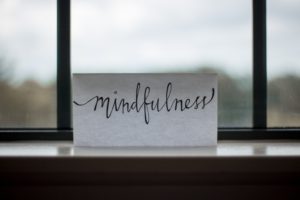
Photo by Photo by Lesly Juarez on Unsplash
One of my taglines about mindfulness is that “it’s easier said than done.”
I think it applies to almost all aspects of cultivating and maintaining a mindfulness practice. Well it also applies to almost all things in life period.
But here’s the thing about mindfulness…it’s super simple! It’s just not always easy.
And by simple, I mean that there’s not a lot to it. In fact, the instructions are really basic:
Notice, pay attention and be aware of what is arising, meaning your thoughts, your emotions, your sensations in your body, and the distractions around you, practice not judging what arising, and let go of attachments…
It’s not hard.
And yet, why is it so damn hard???
Because we’ve been trained and conditioned to not stay present with what is hard or painful, and to grasp and cling to what we like.
And we have a culture of busyness in which distractions are coming at us constantly and our attention is not trained to be focused.
It’s hard because we have not been taught to sit with our emotions, nor how to not believe our thoughts or how to not let distractions completely take over.
Mindfulness is hard because we are learning an entirely new skill, that “should” feel like second nature but is not. I actually assert that we’ve been conditioned to be unmindful as we’ve grown up.
Think about little kids…
…they are inherently mindful. They almost all wear their hearts and emotions on their sleeves and don’t have the internal monologue (yet!) to tell them they shouldn’t.
Kids cry when they’re sad, they have a tantrum when they are angry, they laugh at everything without worrying what people think of them, they eat when they are hungry, they stop when they’re full, they play with what’s in front of them, they sleep when they’re tired…
And then one day, someone tells them not to feel what they feel at the moment they are feeling it. Or they are taught to not want the toy in front of them because they are supposed to be doing something else. Or they are modeled keeping their emotions in to make the others around them more comfortable.
Our mindful nature is inherently in us – we have to unlearn the conditioning that took it away from us.
So how do you begin?
Well it’s simple:
- Set the intention that you want to practice being more present and aware
- Connect with your WHY – what do you hope to gain by being more present and aware (the more advance level of this practice is to have non-attachment to the outcome, but it’s a good place to start to know why it is you want to practice, like less stress or worry, more connection with loved ones…)
- At again given moment, hit the “pause” button on your day, and just notice what you notice (thoughts, emotions, sensations, distractions)
- Connect with an anchor to ground you into the present moment (your breath, your feet on the ground, something you see, feel, smell, or hear)
- Name what you see with a simple, non-judgmental label (“oh, there’s a thought about the laundry” or “cars whizzing by” or “pain in my lower back”)
- Resist the urge to create a story about what you are noticing (i.e. “I have so much to do, when am I going to get to all that laundry, I hate that chore, why don’t I get any help, and why do I suck so much at keeping on top of it?!” or “I wonder where that car is going? Who is in it? Why did they choose such a loud car? Don’t they care about the environment or people around them?)
- Come back to your anchor…breathe in, breathe out.
- Resume your everyday life
See? That simple!
Try doing that at least 2-3 times per day, and as you can see, it only needs to be like a 10 second exercise. You have 10 seconds, right??
And what’s going to happen is in that 10 seconds you’ll start to notice things that you normally push away, deny, resist, or ignore…and the key is that you’ll start to neutralize that response.
Then the more you do it, the easier it becomes.
Simple right??
Let me know when you try it and if I can help with where you are stuck…or just keep following my blog posts and gain more tools!


